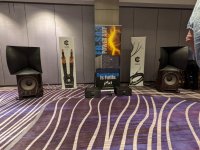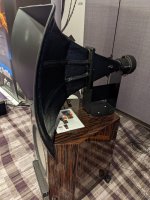It's quite funny, and perhaps also illustrative of 'personal preferences', to read that some people rated the PBN 2 way (one of the) best of the show, while others didn't like it that much.
Such a system should work best in a larger room where the listening distance is at least 4-5 meters.
Not to stir up another discussion , but the astigmatism that is inextricably linked to long diffraction horns is most likely less disturbing at a greater distance. What remains is a huge soundstage and ditto dynamics.
, but the astigmatism that is inextricably linked to long diffraction horns is most likely less disturbing at a greater distance. What remains is a huge soundstage and ditto dynamics.
Better pictures:
Such a system should work best in a larger room where the listening distance is at least 4-5 meters.
Not to stir up another discussion
Better pictures:
Attachments
Last edited:
What driver is that image of please Ro808? By the surround I'm thinking a Celestion?2x 4x15" FLH (1.6-1.8m length) in an untreated rectangular room iirc.
The Scan-Speak Ellipticor 38WE is good, but for € 1,600.00 (each) you could buy 11 pieces of this woofer last year:
View attachment 1068187
Not like you can order them. 55K is nuts!The question remains why the 2360a was chosen over the improved 2360b.
Rob
Thank you for your advice....I don't believe this is xlim..... I've been told that it would be a very obvious event when I began to hit the phase plug.... The low 2nd order distortion vs the 3rd really confuses me but then again, what do I know. I thought usually 2nd order is dominate.When a HF diaphragm reaches Xlim, that is, contacts the phase plug, it makes a "ticking" or "clacking" sound.
That sound's primary envelope will probably be centered above 4000 Hz, and won't change regardless of the fundamental frequency that has caused it.
REW does not read distortion above the 9th harmonic, the 9th harmonic of 200Hz is 1800Hz, reaching Xlim may not show up as harmonic distortion until above 400Hz, where another +6dB output could be expected without damage.
If I pull the mic away from the exit it starts to shape up more expectedly results and 2nd order becomes dominate...I can make sense of that....
So it seems that with a 2nd order XO at 200hz there is headroom....this is not exactly reflecting an effective 200hz in combination with the natural roll off.
Last edited:
This was taken at 12" away, inside. I need to get outside to see how it changes. I had a much higher spl measurement but I deleted it on accident. Something like 120db at 12" was the deleted measurement and distortion was fine. This is a 48db bessel at 200hz. According to the distance/volume calculator the 120db at 12" turns into about 109.6 at 1m.

My method has been to find 2nd order distortion, ~10% within the sub range, while measuring in the throat or on the exit. And then seeing how loud that turns into while measuring the full passband at a reasonable distance from the mouth.
I also played with the woofer + Horn yesterday.....200hz is definitely a good choice for the issue of summing. The horn sitting faced up and next to or at least near the mid woofer, did "gel" (ie. take a definite form or begin to work well.)....considering the un-optimal placing.
I also played with the woofer + Horn yesterday.....200hz is definitely a good choice for the issue of summing. The horn sitting faced up and next to or at least near the mid woofer, did "gel" (ie. take a definite form or begin to work well.)....considering the un-optimal placing.
The inverse distance (inverse square) law applies in the far field, in the near field and inside the horn it does not apply.This is a 48db bessel at 200hz. According to the distance/volume calculator the 120db at 12" turns into about 109.6 at 1m.
Second order distortion is not a reliable indication of a compression driver's (or woofer's) suspension limit.
In post #10,567 the peak sample of 0.0 dBFS at 119.05 dB indicates clipping has occurred.
The inverse distance (inverse square) law applies in the far field, in the near field and inside the horn it does not apply.
Second order distortion is not a reliable indication of a compression driver's (or woofer's) suspension limit.
In post #10,567 the peak sample of 0.0 dBFS at 119.05 dB indicates clipping has occurred.
Yes, the mic is at its limit.
How to use measurements to reliably indicate the compression drivers suspension limits?
Will the Oscilloscope give tell???
Should I say that 10% 2nd order distortion can safely be called Within Xmax???
Last edited:
The inverse distance (inverse square) law applies in the far field, in the near field and inside the horn it does not apply.
Second order distortion is not a reliable indication of a compression driver's (or woofer's) suspension limit.
In post #10,567 the peak sample of 0.0 dBFS at 119.05 dB indicates clipping has occurred.
That's true, but it's probably difficult to obtain reliable near field measurement data without professional/lab instruments and methods.
Trying to measure the limits of the Axi through distortion without measuring equipment capable of it or an environment conducive to it seems like an exercise in futility to me. camplo I understand where you are heading and why you have tried to do it the way you have but the measurement above shows some of the issues you face. The distortion is barely above the noise floor and the regular peaks at harmonic intervals does not look like driver distortion.Yes, the mic is at its limit.
How to use measurements to reliably indicate the compression drivers suspension limits?
Will the Oscilloscope give tell???
Should I say that 10% 2nd order distortion can safely be called Within Xmax???
Below 300Hz things start to get more uneven in frequency response which would track with getting below an octave above cutoff, I struggle to see why you would want to push into that with this horn.
Trying to nerd out this linear true peak thing While retaining the great summing of the 200hz xo point. I probably don't need it at 115db but I'll investigate what that may look like non the less. Having true linear peak ability isn't something that one can hear easily, I'd imagine. You'd have to be able to measure it.Hello Campo
You are using DSP no?? Why are you bothering with all this?? Build them set the crossover where it works best for your desired SPL level and your done! Rob
Its not "that" choppy is it? +/-3db.....should be able to be fixed with eq and the summation of the mid woofer....Below 300Hz things start to get more uneven in frequency response which would track with getting below an octave above cutoff, I struggle to see why you would want to push into that with this horn.
The harmonic peaks of the upper midrange is definitely from something non driver/horn related so I just ignore it.
Pretty much everything I can get out of the horn come across as much less "room" hence my attempt to maximize this attribute.
It should suffice for most of us, but your SPL requirements are higher.
My Spl requirements have been 115db at one meter but I have been trying to thread the needle for Xo point vs headroom.. To be honest the horn sounds best with no XO.....I know that any peak signal below cutoff can still send the diaphragm into distortion, so I am trying to avoid that by determining whats happening below the cutoff and XO points.....Seems to be going in the right direction. It might be wise to (also) listen for possible differences of HPs at 200 vs 400 Hz.
If I focused on 75db average its safe to say that the system can be transient perfect at that level and 200hz XO. 75db is the recommended mastering monitoring level....I'd like to retain the trait at 95db or so.... I know that with DSP I'm dealing with flexibility, but I also have to know where I am, to begin with.
Last edited:
If I thought this statement was true I wouldn't have said what I did. Trying to equalize diffractive ripple is another fools errand because when you move your mic the ripple moves too.Its not "that" choppy is it? +/-3db.....should be able to be fixed with eq and the summation of the mid woofer....
You can't ignore it if the measurement is to mean anything, you need to isolate it and remove the source, or if not throw that measurement away.The harmonic peaks of the upper midrange is definitely from something non driver/horn related so I just ignore it.
- Home
- Loudspeakers
- Multi-Way
- Is it possible to cover the whole spectrum, high SPL, low distortion with a 2-way?

